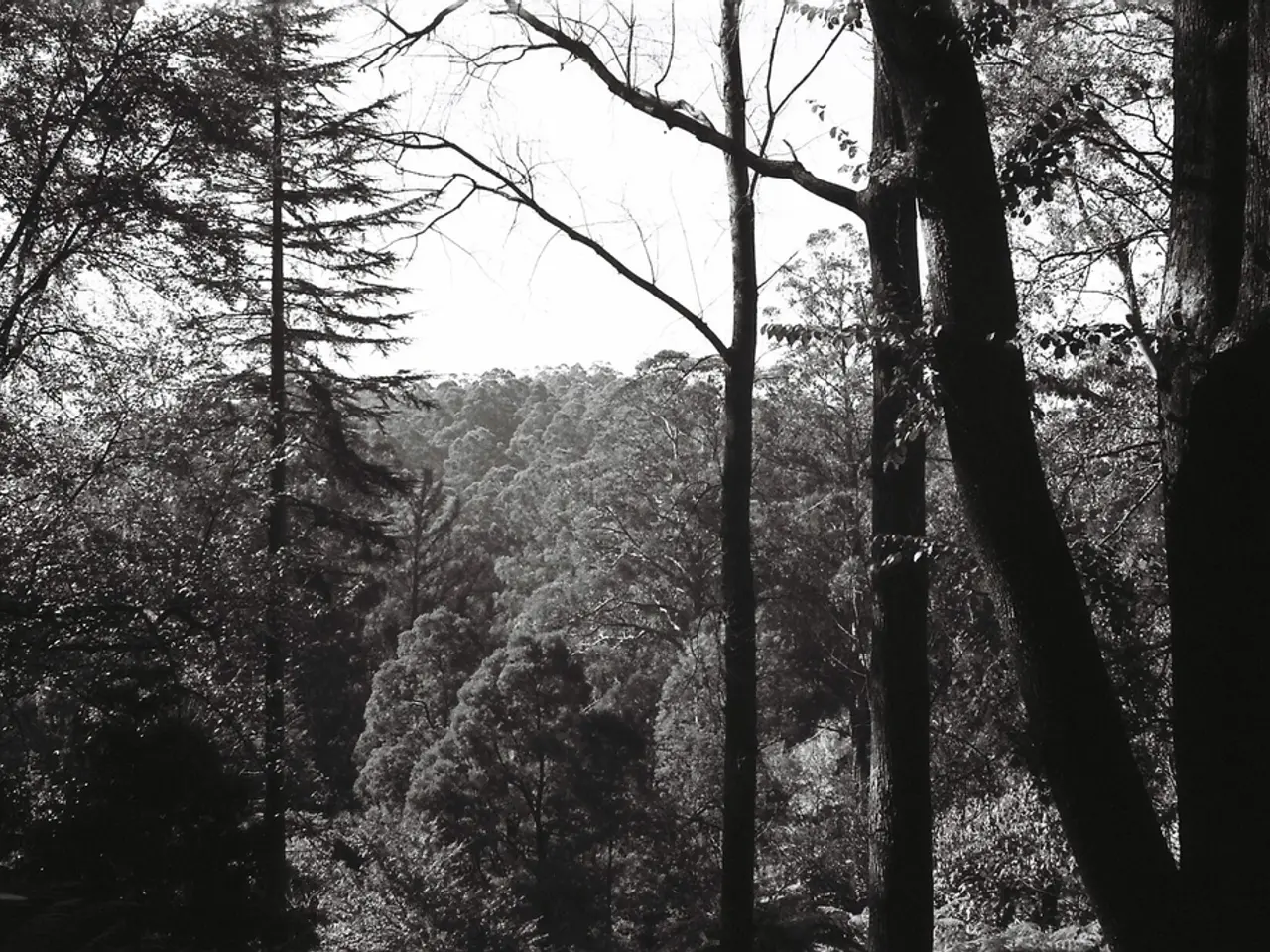Extreme trees from around the globe thrive under harsh conditions. Pondering whether to cultivate these resilient specimens in your own garden?
Exploring the World's Most Extreme Trees: A Look at the Tallest, Northerly, and Southerly Species
In the realm of botanical marvels, some trees stand out as the most extraordinary. This article delves into the world's highest, most northerly, and most southerly notable tree species.
The current record for the world's tallest tree belongs to Hyperion, a Coast Redwood (Sequoia sempervirens) located in Redwood National Park, California, USA. Reaching about 379.7 feet (115.7 meters) tall, Hyperion towers above its fellow redwoods [1]. While Coast Redwoods are sometimes cultivated in the UK on a smaller scale, seedlings or saplings of the actual tree Hyperion itself are not commercially available due to its protected status and the desire to preserve it from potential damage.
The world's most northerly tree is not explicitly identified, but hardy species such as some varieties of spruce, pine, or Arctic willow thrive in the high Arctic regions, including northern Greenland or Siberia. Specific named specimens are not listed in the provided results.
The world's most southerly notable tree species is the kauri (Agathis australis), a large conifer native to northern New Zealand (north of 38°S latitude). Kauris can reach up to 50 meters (160 feet) tall [4]. However, due to its New Zealand origin and biosecurity and conservation concerns, the kauri is uncommon and non-commercial in the UK.
Another intriguing tree is the Magellan's beech (Nothofagus betuloides), which grows on Isla Hornos, the southernmost island in the Cape Horn archipelago at the very tip of South America. Despite its extreme location, these beeches manage to survive by growing sideways rather than vertically when conditions are poor [2]. The Magellan's beech is a broadleaved evergreen and can be found in cultivation, although it may not be as widely available as other species.
In contrast, the Dahurian larch (Larix gmelinii) from the Taimyr Peninsula in Russia thrives in a much harsher climate, with long, cold winters and short, cool summers. This deciduous conifer is adapted to withstand the extreme cold of its native habitat [3]. While not as tall as the Coast Redwood or Kauri, the Dahurian larch is a remarkable tree in its own right.
One noteworthy tree that is not in cultivation, despite being the most garden-worthy of the three trees mentioned, is the Polylepis tarapacana. A recommended alternative is Polylepis australis, which is in cultivation.
In summary, while some species related to the world's highest tree (Coast Redwood) can be purchased as saplings in the UK from specialist nurseries, the actual record-holding trees or the most extreme northern/southerly species are generally not available for purchase there under normal circumstances.
| Tree Type | Species | Location | Height/Characteristic | Availability in UK | |-----------------------|--------------------------|----------------------------|---------------------------------------|-----------------------| | World's highest | Coast Redwood (S. sempervirens) | Redwood National Park, USA | 379.7 ft / 115.7 m | Coast Redwoods sold as saplings; not Hyperion itself[1] | | World's most northerly | Not specified | Arctic regions (general) | Hardy, small trees/shrubs | Generally not commercially available | | World's most southerly | Kauri (Agathis australis) | Northern New Zealand | Up to 50 m tall | Uncommon/non-commercial due to origin[4] | | Extreme Conditions | Magellan's beech (N. betuloides) | Isla Hornos, Cape Horn archipelago | Grows sideways; relatively mild climate[2] | In cultivation, but not widely available[5] | | Extreme Conditions | Dahurian larch (L. gmelinii) | Taimyr Peninsula, Russia | Deciduous conifer; extreme cold[3] | In cultivation, but not widely available[6] | | Garden-worthy Alternative | Polylepis australis | N/A | In cultivation | Available in the UK[7] |
[1] https://www.nps.gov/redw/learn/nature/worlds-tallest-tree.htm [2] https://www.sciencedirect.com/science/article/pii/S1389934216301969 [3] https://www.ncbi.nlm.nih.gov/pmc/articles/PMC3739759/ [4] https://www.nzherald.co.nz/nz/news/article.cfm?c_id=1&objectid=11938205 [5] RHS Plant Finder (accessed 2022-01-24) [6] RHS Plant Finder (accessed 2022-01-24) [7] RHS Plant Finder (accessed 2022-01-24)
- Incorporating plants from diverse landscapes, such as gardens, into one's lifestyle can foster a greater connection with nature.
- The kauri, a prominent tree native to New Zealand, is not only the world's most southerly notable tree species but can also reach impressive heights of up to 50 meters.
- Some varieties of spruce, pine, or Arctic willow are hardy trees that thrive in the high Arctic regions, such as northern Greenland or Siberia, making them ideal additions to a home-and-garden setting that aims to showcase nature's diversity.
- While one may find Magellan's beech trees in cultivation, they may not be as widely available as other species due to their extreme growing conditions and limited distribution.




